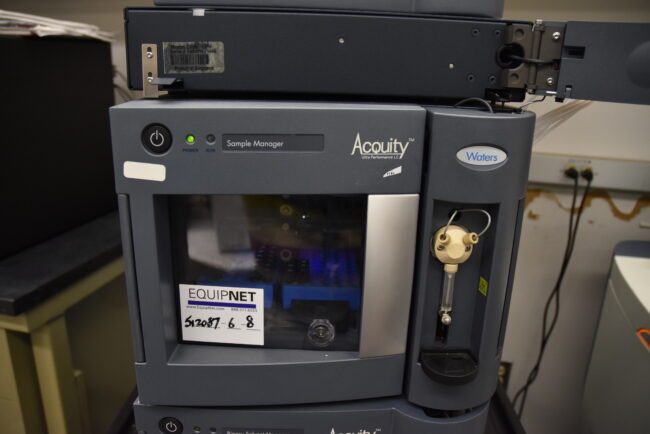Menu
About the Chemical Analysis and Detection Core
Our Laboratories
Organic Analysis
A majority of the effort in methods development for organic analysis has been in support of our researchers in their studies of neurotoxicology. The laboratory recently created new methods for analysis of pesticides in cell culture, catecholamines in plasma, and PCBs in serum. In addition we have utilized the new HPLC/MS technology to evaluate degradation products of drugs used in emergency response kits as well as pharmaceuticals found in drinking
Inorganic Analysis
A majority of the effort in methods development for inorganic analysis has been directed toward differentiation of various metabolites of toxic metals found in human biological samples. For example, we have utilized a method for quantifying the toxic forms of arsenic and have developed a new method for separation and quantitation of two organometallic forms of chromium. Biomonitoring work has been performed on populations with known or suspected exposures to these contaminants in their environment. Direct support was provided to Rutgers University by collecting and analyzing turf field samples for heavy metals and organic contaminants when the safety of the material was called into question. A similar response with rapid analysis was provided for the city of Newark.
Sample Preparation
The EOHSI Analytical Core Laboratory receives samples for analysis from a variety of sources including investigators from the university community and state agencies. Samples are typically received by laboratory staff; inspected for damage; logged into the laboratory data base; assigned a unique sample number; labeled properly; and stored at the appropriate temperature to await preparation and analysis. All aspects of sample receipt adhere to written Standard Operating Procedures (SOPs) and established Quality Assurance protocols. Additionally, rigorous chain-of-custody paperwork and methodology are maintained.
Samples may be received in a variety of forms including soil, water, and biological materials, as well as less typical matrices (e.g., artificial turf, garden hose, and plush children’s toys to name a few recent novel matrices). Depending on the type of sample and the method of analysis, samples will proceed along the sample preparation continuum. Typically, the Analytical Core Laboratory will analyze several QA/QC samples for each batch of samples being prepared for analysis, including preparation blanks (used to determine level of background interference); laboratory control samples (used to monitor the accuracy of the analytical method); matrix spike samples (used to evaluate the effect of the sample matrix on the accuracy of the analytical method); and sample duplicates (used to evaluate the precision of the analytical method).
Under the direction of Dr. Buckley, the CAF has twenty years of experience in developing novel analytical methods. Sample preparation methodology may include microwave assisted acid digestion for inorganic analysis and solvent extraction for organic analysis.
Prior to the analysis of a batch of samples, standard calibration curves of signal response vs. analyte concentration are generated for each analytical instrument. The number and concentration of calibration standards required to generate the calibration curve are specific to the various analytical methods. The principal analytical methods employed by the CAF include gas chromatography (GC); gas chromatography-mass spectrometry (GC-MS); and inductively coupled plasma-mass spectrometry (ICP-MS).
New Capabilities
Within the inorganic analysis specialty lies a unique capability, specifically inorganic and organometallic speciation using a high resolution magnetic sector ICP/MS. The magnetic sector instrument has already proven to be 2 to 3 orders of magnitude more sensitive than our quadrupole instrument for many elements and operates at higher resolution, removing many of the isobar interferences in our current assays. For example the chromium isotope at a mass to charge of 52 suffers from isobars of argon carbide and argon oxide. Operating the magnetic sector instrument at 4000 we can completely remove this isobar interference from our chromium measurements. Coupled with the separation capabilities of an ion chromatograph, it allows us to speciate or differentially quantify both chromium III and chromium VI in drinking water to levels well below 10 ppb. The ICP/MS we use for this measurement is a Nu Instruments Attom and the ion chromatograph is a Metrohm.
In addition to quantitation and speciation at much lower levels than previously possible, the higher resolution ICP/MS allows us greater precision in isotopic ratio measurements. This is important because stable isotope labels can be used to identify an element introduced into an experiment rather than one already present. For example if we wish to study the uptake of magnesium in a cell culture we can use the labeled form or the isotopically enriched form to discriminate from the magnesium already present in the cell. With the quadrupole instrument our isotopic precision was roughly 2%. With a high resolution instrument our precision is below half a percent.
We’ve just begun to explore the capabilities of the high resolution ICP/MS with the ion chromatograph interface for many biological and environmental applications.
The instrument was purchased with funds from the National Institutes of Health shared instrumentation grant program.
Our ResearchTeam
Dr. Brian T. Buckley – Director
Executive Director of Laboratories – Associate Director of Administration
Environmental and Occupational Health Sciences Institute
Rutgers University
Copyright © 2021, Rutgers, The State University of New Jersey






